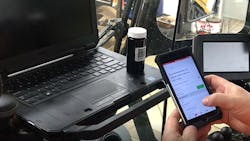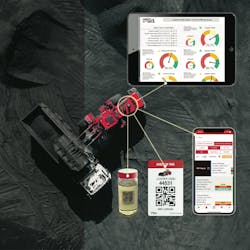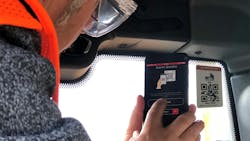Integrate oil analysis with machine data
Maintenance management
- How to prevent fluid contamination.
- Prevent unscheduled equipment failures.
- How to preventive maintenance systems efficient.
- How to create a metric to analyze downtime and productivity.
Key takeaways
- How oil analysis complements machine data
- A fleet case study
- How to build a reporting system
Inflation and long lead times for new equipment are among the financial pressures pressing down on fleet managers to extend machine life. Pushing a machine too far results in loss of availability and utilization. A tried-and-true tool for machine health, oil analysis, has evolved with the advent of telematics to interact with machine data in a way that makes these decisions not only easier but also increases the odds that they will be successful.
As a service, oil analysis has adapted to the new digital world to continue to provide value to the fleet asset manager. It is no longer enough to provide a web portal to manage oil analysis programs and view sample reports. Equipment-using organizations are expecting a tighter level of machine-data integration to drive higher levels of efficiency in all aspects of their business, and fleet maintenance is no exception.
Modern fleets today utilize Computerized Maintenance Management Systems (CMMS). Some estimate that fleet maintenance costs have increased 50 percent over the past five years with 20 percent of those costs associated with vehicle breakdowns and unplanned service events. A CMMS assists in lowering maintenance costs and increasing uptime by reducing unplanned service events. Effective use of a CMMS within a fleet will result in longer machine life and higher machine residual values. The world of CMMS is rapidly changing as many systems today include Machine Learning (ML) and Artificial Intelligence (AI) that learn to predict common machine failures from the machine telemetry information. Every CMMS that includes telematics employs a RESTful Application Programming Interface (API). This API interface allows the CMMS to both receive and transmit information to the machines in the field.
Owing that oil analysis is a well-established predictive maintenance strategy, integrating oil analysis results into an existing CMMS through the API interface enhances the predictive nature of the system and greatly assists in reducing unplanned machine failure. Oil samples that are flagged for harmful contaminants or that indicate abnormal wear prompt a notification to be sent through the CMMS API. These notifications automatically integrate into the scheduled maintenance plan for the machine. The value here is that the oil analysis program integrates seamlessly into the existing CMMS maintenance architecture.
Ben Caldwell, CEM, equipment manager for Manhattan Road and Bridge, has seen an increase in fleet uptime as the result of integrating its oil analysis program with its CMMS.
“Any machine problem that our oil analysis provider detects gets sent automatically by their API portal as a notification to our HCSS API portal,” Caldwell says. “The notification is then easily vetted from within our CMMS to create the necessary service work order. Having the notifications populate directly in our CMMS means we are better able to schedule follow up work and reduce the need to maintain access to a separate system to manage oil sample alerts.”
Of course, oil analysis is only valuable if samples are taken and submitted to the laboratory. The resources required to manage an oil analysis program for a large fleet are considerable, but again, today’s digital technology is reducing the number of resources required while at the same time increasing both data compliance and data accuracy. CMMS telematics provides a gateway to the machine information required for an accurate oil analysis sample. The use of an oil analysis mobile application integrated with fleet asset tags replaces the need to fill out oil analysis sample information forms.
Todd Perrine, CEM, VP of product support for Leslie Equipment, manages a large oil analysis program and is no stranger to the amount of time it takes to administrate an effective program. Incorporation of new digital technology has benefited the program enormously.
“Utilization of our oil analysis provider’s online sample submission program, along with the use of asset tags, has allowed us to reduce the time it takes to complete our oil analysis submissions by 75 percent,” says Perrine. “That’s equivalent to gaining back one-half of a full-time employee.”
“With our integration into the API, we now add all new machines and their sampling compartments to our laboratory’s database each morning,” says Mike Johnson, IT director. “When we pull up a service order for a machine, our CMMS automatically makes a sampling request to the API interface, which instantly sends us back a PDF of the oil sample tags for each sampling compartment in the service order. There’s no more oil sample paperwork for the technician to fill out.” CMMS APIs allow for a tight integration between the oil analysis customer and vendor.
Keeping track of new assets and sampling compartments is tedious for large fleets, but the use of an API automates this chore and ensures that the fleet machine database is synchronized with the oil laboratory. James River operates more than 40 distributor locations and adds many new machines a day to its fleet.
Customized report tracks costs
A CMMS that is Vehicle Maintenance Reporting Standards (VMRS) compliant goes even further than a conventional CMMS and allows for the tracking of maintenance activities and costs.
The author developed a management reporting tool that was able to determine the effectiveness of the oil analysis program by combining machine oil analysis results with VMRS maintenance records to identify when maintenance activities were carried out after the identification of an oil-related issue from the most recent oil analysis results. The follow-up oil analysis results were also integrated into the model to determine if the maintenance tasks were effective in correcting the maintenance issue identified by the oil analysis.
The result is a monthly report that provides the true return on investment (ROI) from the oil analysis program by taking into account the costs of maintenance required to resolve the oil-related issue in addition to the cost of the oil analysis program. Even when maintenance parts and labor for repairs and inspections were factored into the model, the ROI for the oil analysis program was 10:1. The VMRS model also enabled us to calculate repair ratios for the fleet, in essence showing effective each region was at repairing each oil-related issue such as dirt ingression or glycol leak.
Repair ratio reporting opens a window into maximizing fleet reliability by identifying maintenance practices that require improvement. For instance, if the northeast region of a fleet has only a 50 percent repair ratio on glycol leaks, as compared to 90 percent for the southern region, then an examination of maintenance activities and cross-training of maintenance skills could be employed across the regions to improve that repair ratio. One estimate of a repair ratio deficiency in a national waste management fleet, for example, demonstrated that more than $250,000 was spent on engine failures where the oil-related problem was identified but not properly corrected, and this was only for a three-month period.
The integration that today’s digital technology allows has the potential to cut fleet maintenance costs dramatically.
The next step is integrating these management results with the organization’s business intelligence dashboards. One North American waste management company has been dramatically improving fleet uptime while reducing maintenance costs through the effective management of the fleet’s oil analysis program. They are using the laboratory’s bi-monthly management reports to drive their oil analysis program to enhance fleet sustainability. As a result, they are taking the next step to integrate these management statistics into their daily business intelligence dashboards across the fleet.
Old-school oil analysis can readily be integrated into today’s digital machine technologies and software to provide more detailed insight into machine health. With a clearer picture, asset managers will be able to extend machine life where possible as well as enhance overall efforts to maintain reliability and utilization.
About the Author
William Quesnel
Bill Quesnel is president of WearCheck Canada and has developed his experience over the last 30 years in the industry helping many large companies establish successful oil analysis programs. Bill graduated from the University of Waterloo in pre-med with minors in Biology, Chemistry and Computer Science. Bill is CLS, OMA II, MLA III, MLT II, LLA I certified and a member of the STLE OMA Committee.



